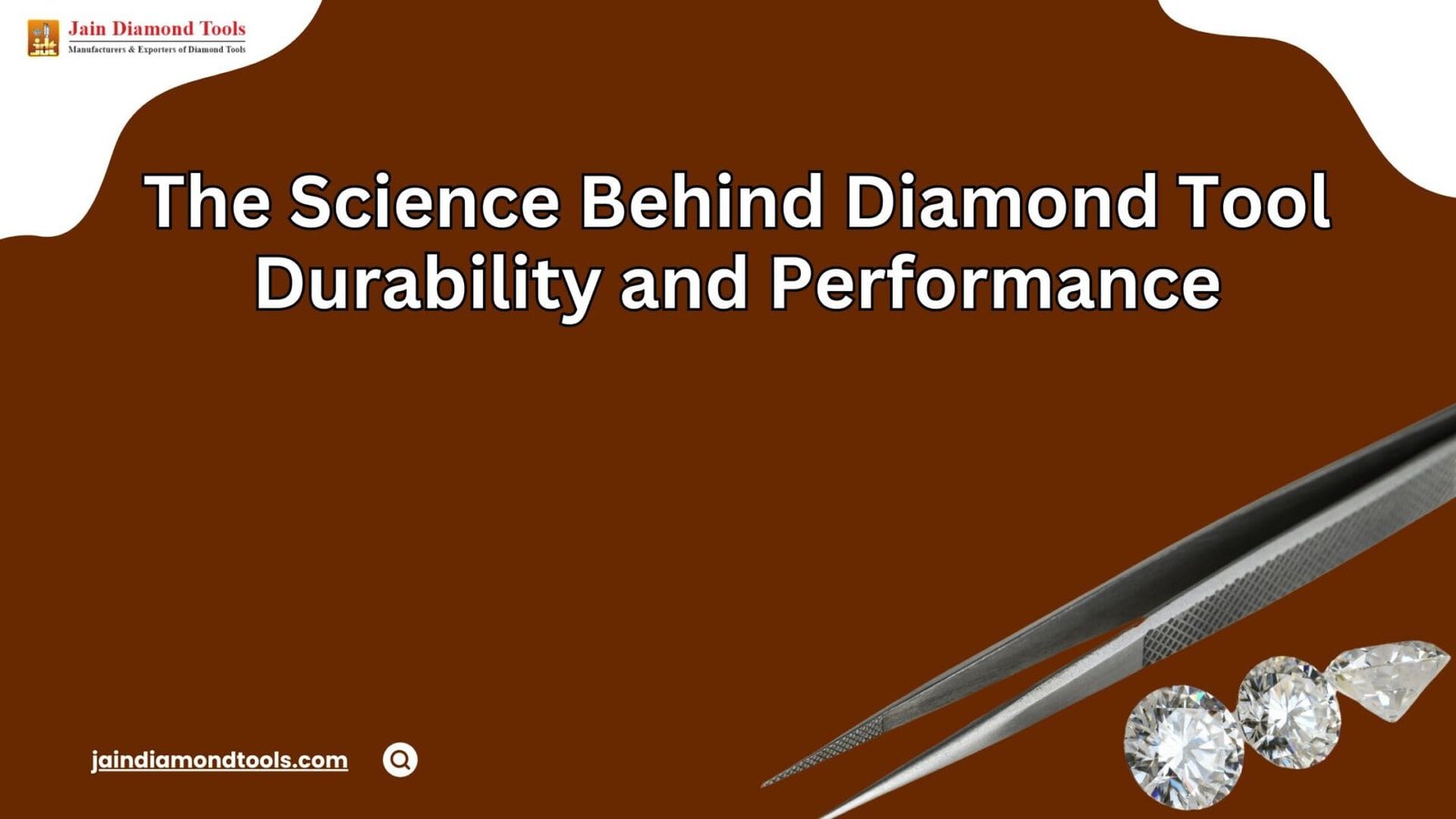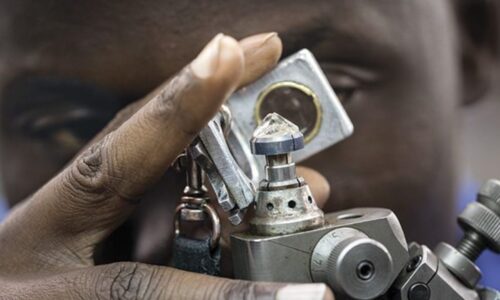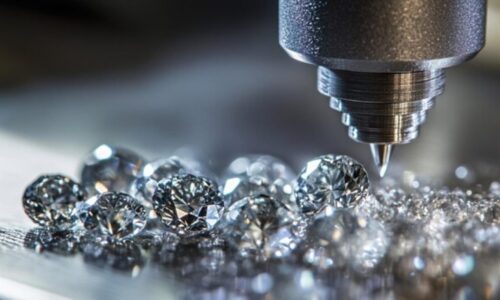
The Science Behind Diamond Tool Durability and Performance
- By akshada
- Posted on
In construction, mining, manufacturing, and many more, diamond tools are favored for cutting, drilling, and grinding of hard materials. Highly compared with ordinary traditional tools in terms of performance and durability, what makes diamond tools durable? What contributes to their superior performance? This blog will explore the science of diamond tool durability and performance. We will look at intricate technology, materials, and even engineering principles that make these tools indispensable in extremely demanding situations.
Jain Diamond Tools aims to be the leading manufacturer of high-performance diamond tools that last longer, cut cleaner, and work faster. The scientific principles underlying these tools result in knowing how and when to make an informed decision between choosing the right diamond tool for the specific application.
What Makes Diamond Tools So Durable?
Diamond tools owe their strength to the outstanding characteristics of diamonds. They are the hardest natural material on earth. The hardness value is a whopping 10 on the Mohs scale. It simply means immense pressure, high temperatures, or friction without breaking down or wearing out fast.
Key Factors Behind Diamond Tool Durability:
- Diamond Hardness
Diamonds are composed of carbon atoms that form a very hard, tetrahedral structure. The hardness this provides makes diamonds scratch-proof, cutting-proof, and break-proof, so diamond tools can use the hardest of materials-cement, asphalt, and stone. - Bonding Technology:
A diamond tool has diamonds dispersed in a metal, ceramic, or resin matrix. It is through the bonding material that determines the lifespan of a tool. When the bond wears away, it slowly starts to break, exposing newly exposed diamonds to perform the cutting operation. The right bonding material ensures maximum services from the tool, thereby making it last longer. - Synthetic Diamonds:
Though most of the high-end tools will contain some natural diamonds, the major usage these days is actually synthetic diamond tooling. The synthetic diamond is made in a controlled atmosphere and does have uniform properties, which are beneficial for longevity and predictable performance. - Segment Design:
The diamond segments hold the particle of diamond that is designed to continuously offer resistance to the very high cutting forces. The designs and shapes of these segments are optimized for uniform wear on the segment, thus ensuring tool longevity.
Factors Affecting Diamond Tool Performance
There are various factors on which the performance of a diamond tool depends. In some cases, it can be the material being cut or the speed at which the tool operates. Understanding these factors helps users optimize the performance of diamond tools.
1. Material Hardness:
The material being cut would always impact the performance of tools. A more potent tool and higher-quality diamond bond are found in tools for harder materials like granite and concrete. Tools for softer materials, such as asphalt or limestone, use softer bonds; these are used until they wear away to reveal fresh diamonds.
2. Diamond Concentration:
In addition, tool performance is affected by the concentration of diamonds in the tool. A higher concentration of diamonds will show better cutting but will wear down the bond faster. Lower concentrations of diamonds may result in slower cutting but more prolonged tool life. Thus, the ultimate point is reached when a sweet spot for maximum efficiency is achieved.
3. Cutting speed and pressure:
The speed at which the tool is operating also defines performance. The right speed while cutting smoothly operates tools. Excessive speed or pressure causes the cutting tool to overheat, damaging the equipment and reducing the lifespan of a tool. Controlled pressure also avoids cracking or chipping of materials being cut.
4. Wet vs. Dry Cutting:
The tool can perform much better and live longer if water is used in cutting to cool the tool. The presence of water limits friction and overheating, which directly contribute to preventing wear from developing before time. Dry cutting is the procedure that mainly applies in small projects; cooling does not necessarily have to occur but may lead to quick wearing of the tool.
Understanding Diamond Tool Wear
Diamond tools are very durable, but they also wear out. Their wear is of great importance in determining the ultimate performance as well as lifetime. In this paper, the nature of diamond tool wear and how to extend their life length are discussed in more detail.
1. Abrasion Wear:
Abrasion is the predominant wear mechanism for diamond tools. In abrasion, the tool wears away the bonding material by contact with the material, exposing new diamond particles. The rate at which the bond is worn away is critical: it should be worn away quickly enough that it does not take too long, but fast enough that the diamonds are exposed too quickly, and not so slowly that the diamonds become dull before new ones are exposed.
2. Diamond Fracture:
Under stress, even the hardest diamond particles could crack. Mostly, that happens during cutting very hard material, such as granite. The size and grade of the diamond particles will determine the ease with which they may shatter or break. High-grade synthetic diamonds do not break up so easily, hence the tool lasts longer.
3. Bond Erosion:
With time, the matrix that supports holding the diamonds in position becomes worn out through heat, pressure, and friction. The rate of erosion of the bond is dependent on the cutting speed, cooling method implemented, and the material being cut. Wet cutting slows down the erosion of the bond, and dry cutting hastens it.
4. Heat Damage
Overheating while cutting may cause diamonds to lose their temper, resulting in lower durability and performance. Heat will also bring about the premature loss of the bond, or it may even dull the diamonds. Therefore, cooling with water during its application is also necessary, along with the use of the recommended cutting speed.
How Jain Diamond Tools Optimizes Durability and Performance
Mastering the art of durability with performance is what we have learnt at Jain Diamond Tools. Advanced manufacturing processes, the use of cutting-edge materials, and comprehensive testing ensure that tools from the company are going to be up to the task for the most difficult jobs, while delivering results reliably.
1. High-Quality Synthetic Diamonds:
We are utilizing the finest synthetic diamonds in all our tools in such a way that all of them can have uniform sizes, shapes, and strengths. These are made to withstand lots of friction and pressure so our tools become tougher and more efficient.
2. Optimized Bonding Materials:
Our proprietary bonding materials make the best balance between diamond exposure and bond wear. This helps our tools hold cut edge for quite a while, even under such tough conditions.
3. Custom Solutions:
The need for diamond tools is different in various industries. Jain Diamond Tools does solution customization as per application. Concrete cutter tools, stone grinding tools, and drilling tools help in producing maximum output with long-life durability.
4. Stringent Quality Control:
All our tools are well designed to go through the strenuous testing process in order to ensure that we maintain our strict quality standards; hence, we will consider every detail in the development from early design right through to final production in order to ensure that performance is brought forth to the highest level.
The Future of Diamond Tool Technology
While technology is advancing day by day, one even observes an advancement in diamond tool technology. There are certain exciting trends that would actually define the future of diamond tools, as follows:
1. Nanotechnology:
Through nanotechnology advancement, even harder and more durable synthetic diamonds have been manufactured. The wear ability of diamonds is excellent, and tools endure longer and reach further.
2. Smart Tools:
There are smart diamond tools that can be used, fitted with sensors to monitor temperature wear and pressure in their development. They give real-time information and allow the users to optimize their cutting process and extend tool life.
3. Environment-Friendly Production
With the increase of industries moving toward sustainability, manufacturers are now steered toward producing diamond tools as green as possible: low-waste production, energy efficiency, and a sustainable acquisition of raw materials. This alone is driving a much more environmentally conscious manufacturing environment in the diamond tool industry.
4. Advanced Coatings
The new coating technologies that are nowadays designed aim to enhance the durability as well as the effectiveness of diamond tools. These coatings provide additional protection against heat and wear, so they can last longer and work better.
Conclusion
It arises basically from the interaction of diamond hardness, bonding materials, and manufacturing process. This science, therefore, allows industries to choose better tools for their applications. At Jain Diamond Tools, we strive to achieve high-performance tools that increase durability and meet the evolving needs of a variety of industries.
There will continue to be newer efficiencies, higher precisions, and sustainability innovations in the use of diamond tools. Be you in cutting, grinding, or drilling business, Jain Diamond Tools has the best solution for your project.
FAQs
Q-1. What types of diamond tools does Jain Diamond Tools manufacture?
Ans- Jain Diamond Tools manufactures various types of diamond tools in the form of cutting blades, core drills, grinding wheels, and polishing pads for use on different materials.
Q- 2. How can I extend the life of my diamond tools?
Ans- Use the diamond tools at recommended speed ranges, maintain a constant pressure and wet cut whenever possible to avoid overheating.
Q- 3. Are diamond tools suitable for both residential and commercial use?
Ans-Yes, diamond tools can be suited for both residential and commercial applications, keeping them multi-purpose for many applications.
Q- 4. Can diamond tools be repaired?
Ans- Although a diamond tool cannot be fully repaired, they can sometimes have the ability to be re-tipped or re-segmented to their sharp cutting manner.
Q- 5. What safety precautions should I take when using diamond tools?
Ans- Wear proper PPE on your hands, eyes, and face: Always use gloves, goggles, or masks. Read and follow the manufacturer’s instructions for safe operation.





